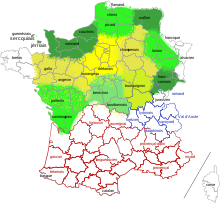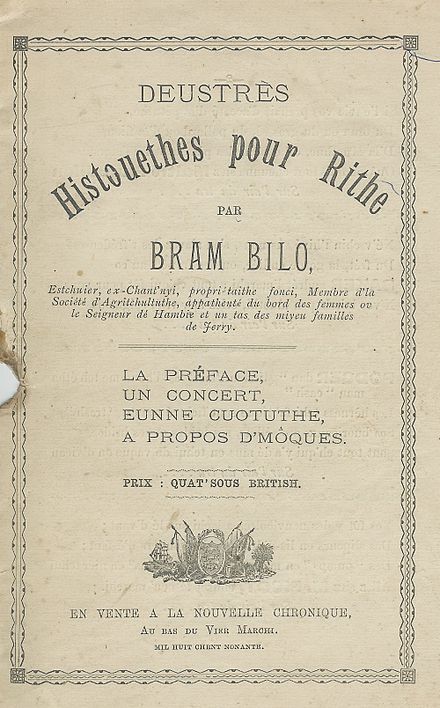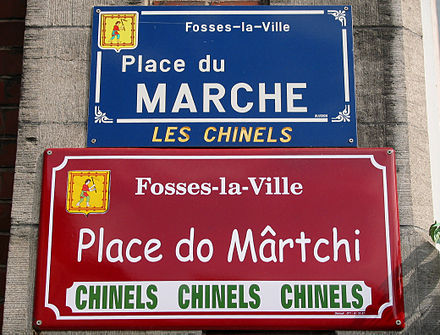Языки d'oïl ( / d ɔɪ ( l )/ doy(l) , [3] США также / d ɔː ˈ iː l / daw- EEL , [4] [5] [Примечание 1] Французский: [lɑ̃ɡ dɔjl] [6] ) представляют собой диалектный континуум , включающий стандартный французский язык и его ближайших автохтонных родственников, на которых исторически говорили в северной половине Франции , южной Бельгии и на Нормандских островах . Они принадлежат к более широкой категории галло-романских языков , которая также включает исторические языки восточно-центральной Франции и западной Швейцарии , южной Франции , некоторых частей северной Италии , Валь д'Аран в Испании и, при определенных условиях, языков Каталонии. .
Лингвисты делят романские языки Франции , и особенно средневековой Франции , на две основные географические подгруппы: langues d'oïl на севере и langues d'oc в южной половине Франции. Обе группы названы в честь слова «да» на их языке или на языках их недавних предков. Наиболее распространенным современным langue d'oïl является стандартный французский, в котором родовое «oïl» превратилось в «oui».
Langue d'oïl (в единственном числе), ойльские диалекты и ойльские языки (во множественном числе) обозначают древние северные галло-романские языки, а также их современные потомки. У них много общих лингвистических особенностей, наиболее заметным из которых является слово «oil» , означающее «да» . ( Oc было и остается южным словом, означающим «да» , отсюда и langue d'oc или окситанские языки ). Самый распространенный современный язык Oïl — французский ( oil произносился как [o.il] или [oi] , что в современном французском языке превратилось в [wi] — oui ). [7]
Есть три значения термина «масло» :
В единственном числе langue d'oïl относится к взаимопонятным лингвистическим вариантам lingua romana , на которых говорят с 9-го века на севере Франции и южной Бельгии ( Валлония ), с 10-го века на Нормандских островах и между 11-м и 14-м веками в Англия ( англо-нормандский язык ). Langue d'oïl , сам термин, использовался в единственном числе с XII века для обозначения этой древней языковой группы в целом. С этими уточнениями langue d'oïl иногда используется для обозначения того же, что и старофранцузский (см. Историю ниже). [8]
Во множественном числе ойльские диалекты относятся к разновидностям древнего языка д'ойль . [ нужна цитата ]
Нефтяные языки — это современные потомки, которые развились отдельно от разновидностей древнего langue d'oil . Следовательно, сегодня langues d'oil может применяться либо: ко всем современным языкам этой семьи, кроме французского языка; или этой семье, включая французов. « Нефтяные диалекты» или «французские диалекты» также используются для обозначения ойльских языков, за исключением французского , поскольку некоторые существующие ойльские языки очень близки к современному французскому. Поскольку термин «диалект» иногда считается уничижительным, сегодня среди французских лингвистов наблюдается тенденция называть эти языки langues d'oïl, а не диалектами . [ нужна цитата ]
Были предложены пять зон частично взаимопонятных ойльских диалектов: [9]

Нестандартные сорта:
Галло имеет более сильный кельтский субстрат из Бретона . Галло произошел от масляного языка народов восточных и северных областей: Анжу ; Мэн ( Майен и Сарт ); и Нормандия ; которые были в контакте с носителями бретонского языка в Верхней Бретани . См. Марши Нейстрии.
Назван в честь бывших провинций Пуату и Сентонж.
Информацию об истории фонологии, орфографии, синтаксиса и морфологии см. в разделе « История французского языка» и соответствующих отдельных статьях на масляном языке.
Каждый из ойльских языков развился по-своему от общего предка, и разделение развития на периоды варьируется в зависимости от индивидуальной истории. Современная лингвистика использует следующие термины:
В 9 веке romana lingua (термин, использованный в Страсбургских клятвах 842 года) был первым из романских языков, который был признан его носителями как отдельный язык, вероятно, потому, что он больше всего отличался от латыни по сравнению с другими языками. Романские языки (см. История французского языка ).
Многие из событий, которые сейчас считаются типичными для Валлонии, появились между 8 и 12 веками. Валлония «имела четко выраженную идентичность с начала тринадцатого века». В любом случае, в лингвистических текстах того времени этот язык не упоминается, хотя и упоминаются другие представители семьи Оил, такие как Пикард и Лоррен. В 15 веке писцы этого региона называли язык «римским», когда им нужно было его различать. Лишь в начале 16 века мы впервые встречаем слово «Валлония» в том же лингвистическом смысле, в котором мы используем его сегодня.
К позднему или послеримскому периоду вульгарная латынь во Франции разработала два отличительных термина для обозначения согласия ( да ): hoc ille («это (есть) оно») и hoc («это»), которые стали oïl и oc соответственно. . Последующее развитие изменило «oïl» на «oui», как в современном французском языке. Сам термин langue d'oïl впервые был использован в XII веке, имея в виду упомянутую выше старофранцузскую языковую группу. В 14 веке итальянский поэт Данте упомянул различия «да» в своей книге «De vulgari eloquentia» . Он написал на средневековой латыни : « nam alii oc, alii si, alii vero dicunt Oil » («некоторые говорят «oc», другие говорят «sì», третьи говорят «oïl»), тем самым различая по крайней мере три класса романских языков. : ок-языки (на юге Франции); языки си (в Италии и Иберии ) и языки ойль (на севере Франции). [ нужна цитата ]
Other Romance languages derive their word for "yes" from the classical Latin sic, "thus", such as the Italian sì, Spanish and Catalan sí, Portuguese sim, and even French si (used when contradicting another's negative assertion). Sardinian is an exception in that its word for "yes", eja, is from neither origin.[10] Similarly Romanian uses da for "yes", which is of Slavic origin.[11]
However, neither lingua romana nor langue d'oïl referred, at their respective time, to a single homogeneous language but to mutually intelligible linguistic varieties. In those times, spoken languages in Western Europe were not codified (except Latin and Medieval Latin), the region's population was considerably lower than today, and population centers were more isolated from each other. As a result, mutually intelligible linguistic varieties were referred to as one language.[citation needed]
In the 13th century these varieties were recognized and referred to as dialects ("idioms") of a single language, the langue d'oïl. However, since the previous centuries a common literary and juridical "interdialectary" langue d'oïl had emerged, a kind of koiné. In the late 13th century this common langue d'oïl was named French (françois in French, lingua gallica or gallicana in Medieval Latin). Both aspects of "dialects of a same language" and "French as the common langue d'oïl" appear in a text of Roger Bacon, Opus maius, who wrote in Medieval Latin but translated thus: "Indeed, idioms of a same language vary amongst people, as it occurs in the French language which varies in an idiomatic manner amongst the French, Picards, Normans and Burgundians. And terms right to the Picards horrify the Burgundians as much as their closer neighbours the French".[citation needed]
It is from this period though that definitions of individual Oïl languages are first found. The Picard language is first referred to by name as "langage pikart" in 1283 in the Livre Roisin. The author of the Vie du bienheureux Thomas Hélye de Biville refers to the Norman character of his writing. The Sermons poitevins of around 1250 show the Poitevin language developing as it straddled the line between oïl and oc.
As a result, in modern times the term langue d'oïl also refers to that Old French which was not as yet named French but was already—before the late 13th century—used as a literary and juridical interdialectary language.
The term Francien is a linguistic neologism coined in the 19th century to name the hypothetical variant of Old French allegedly spoken by the late 14th century in the ancient province of Pays de France—the then Paris region later called Île-de-France. This Francien, it is claimed, became the Medieval French language. Current linguistic thinking mostly discounts the Francien theory, although it is still often quoted in popular textbooks. The term francien was never used by those people supposed to have spoken the variant; but today the term could be used to designate that specific 10th-and-11th centuries variant of langue d'oïl spoken in the Paris region; both variants contributed to the koine, as both were called French at that time.
For political reasons it was in Paris and Île-de-France that this koiné developed from a written language into a spoken language. Already in the 12th century Conon de Béthune reported about the French court who blamed him for using words of Artois.
By the late 13th century the written koiné had begun to turn into a spoken and written standard language, and was named French. Since then French started to be imposed on the other Oïl dialects as well as on the territories of langue d'oc.
However, the Oïl dialects and langue d'oc continued contributing to the lexis of French.
In 1539 the French language was imposed by the Ordinance of Villers-Cotterêts. It required Latin be replaced in judgements and official acts and deeds. The local Oïl languages had always been the language spoken in justice courts. The Ordinance of Villers-Cotterêts was not intended to make French a national language, merely a chancery language for law and administration. Although there were competing literary standards among the Oïl languages in the mediæval period, the centralisation of the French kingdom and its influence even outside its formal borders sent most of the Oïl languages into comparative obscurity for several centuries. The development of literature in this new language encouraged writers to use French rather than their own regional languages. This led to the decline of vernacular literature.
It was the French Revolution which imposed French on the people as the official language in all the territory. As the influence of French (and in the Channel Islands, English) spread among sectors of provincial populations, cultural movements arose to study and standardise the vernacular languages. From the 18th century and into the 20th century, societies were founded (such as the "Société liégoise de Littérature wallonne" in 1856), dictionaries (such as George Métivier's Dictionnaire franco-normand of 1870) were published, groups were formed and literary movements developed to support and promote the Oïl languages faced with competition. The Third Republic sought to modernise France and established primary education where the only language recognised was French. Regional languages were discouraged, and the use of French was seen as aspirational, accelerating their decline.[12] This was also generally the case in areas where Oïl languages were spoken. French is now the best-known of the Oïl languages.

Besides the influence of French literature, small-scale literature has survived in the other Oïl languages. Theatrical writing is most notable in Picard (which maintains a genre of vernacular marionette theatre), Poitevin and Saintongeais. Oral performance (story-telling) is a feature of Gallo, for example, while Norman and Walloon literature, especially from the early 19th century tend to focus on written texts and poetry (see, for example, Wace and Jèrriais literature).
As the vernacular Oïl languages were displaced from towns, they have generally survived to a greater extent in rural areas - hence a preponderance of literature relating to rural and peasant themes. The particular circumstances of the self-governing Channel Islands developed a lively strain of political comment, and the early industrialisation in Picardy led to survival of Picard in the mines and workshops of the regions. The mining poets of Picardy may be compared with the tradition of rhyming Weaver Poets of Ulster Scots in a comparable industrial milieu.
There are some regional magazines, such as Ch'lanchron (Picard), Le Viquet (Norman), Les Nouvelles Chroniques du Don Balleine [1] (Jèrriais), and El Bourdon (Walloon), which are published either wholly in the respective Oïl language or bilingually with French. These provide a platform for literary writing.

Apart from French, an official language in many countries (see list), the Oïl languages have enjoyed little status in recent times.
Currently Walloon, Lorrain (under the local name of Gaumais), and Champenois have the status of regional languages of Wallonia.
The Norman languages of the Channel Islands enjoy a certain status under the governments of their Bailiwicks and within the regional and lesser-used language framework of the British-Irish Council. The Anglo-Norman language, a variant of Norman once the official language of England, today holds mostly a place of ceremonial honour in the United Kingdom (now referred to as Law French).
The French government recognises the Oïl languages as languages of France, but the Constitutional Council of France barred ratification of the European Charter for Regional or Minority Languages.[13]
The langues d'oïl were more or less influenced by the native languages of the conquering Germanic tribes, notably the Franks. This was apparent not so much in the vocabulary (which remained overwhelmingly of Latin origin) as in the phonology and syntax; the invading Franks, Burgundians and Normans became the rulers and their accents were imposed as standard on the rest of the population. This accounts in large part for the relative distinctiveness of French compared to other Romance languages.

The English language was heavily influenced by contact with Norman following the Norman Conquest and much of the adopted vocabulary shows typically Norman features.
Portuguese was heavily influenced by more than a millennium of perennial contact with several dialects of both Oïl and Occitan language groups, in lexicon (up to 15–20% in some estimates, at least 5000 word roots), phonology and orthography.[14][15][16] The influence of Occitan was, nevertheless, the most marked, through the status Provençal in particular achieved in southwestern Europe around the troubadour apex in the Middle Ages, when Galician-Portuguese lyric was developed. Aside the direct influence of Provençal literature, the presence of languages from modern-day France in the Galician-Portuguese area was also strong due to the rule of the House of Burgundy, the establishment of the Orders of Cluny and Cister, the many sections of the Way of St. James pilgrimage route that come from elsewhere in Europe out of the Iberian Peninsula, and the settlement in Iberia of people from the other side of the Pyrenees, arriving during and after the Reconquista.[17][18]
The anti-Portuguese factor of Brazilian nationalism in the 19th century led to an increased use of the French language in detriment of Portuguese, as France was seen at the time as a model of civilization and progress.[19] The learning of French has historically been important and strong among the Lusophone elites, and for a great span of time it was also the foreign language of choice among the middle class of both Portugal and Brazil, only surpassed in the globalised postmodernity by English.[20][21][22][23]
The French spoken in Belgium shows some influence from Walloon. [citation needed]
The development of French in North America was influenced by the speech of settlers originating from northwestern France, many of whom introduced features of their Oïl varieties into the French they spoke. (See also French language in the United States, French language in Canada)